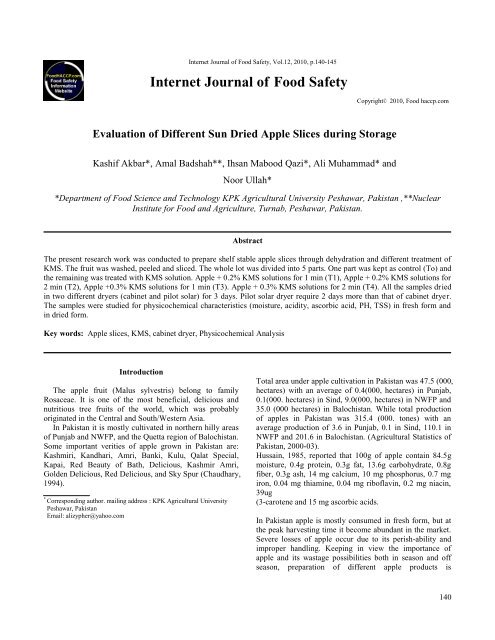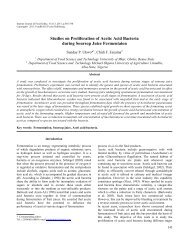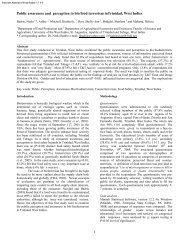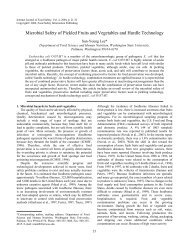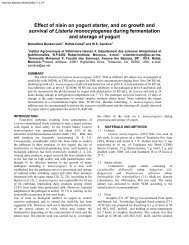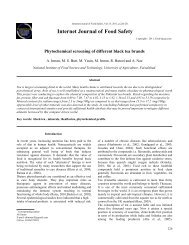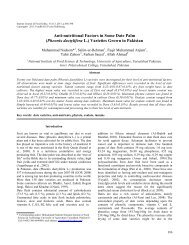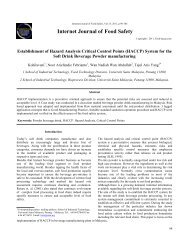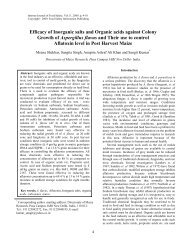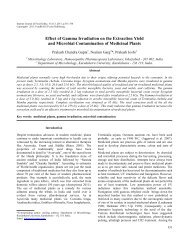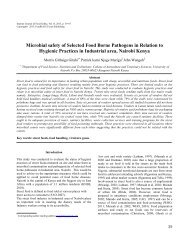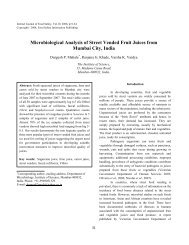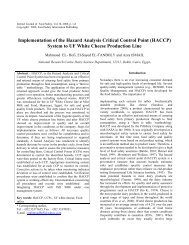Evaluation Of Different Sun Dried Apple Slices During Storage
Evaluation Of Different Sun Dried Apple Slices During Storage
Evaluation Of Different Sun Dried Apple Slices During Storage
You also want an ePaper? Increase the reach of your titles
YUMPU automatically turns print PDFs into web optimized ePapers that Google loves.
Internet Journal of Food Safety, Vol.12, 2010, p.140-145<br />
Internet Journal of Food Safety<br />
Copyright© 2010, Food haccp.com<br />
<strong>Evaluation</strong> of <strong>Different</strong> <strong>Sun</strong> <strong>Dried</strong> <strong>Apple</strong> <strong>Slices</strong> during <strong>Storage</strong><br />
Kashif Akbar*, Amal Badshah**, Ihsan Mabood Qazi*, Ali Muhammad* and<br />
Noor Ullah*<br />
*Department of Food Science and Technology KPK Agricultural University Peshawar, Pakistan ,**Nuclear<br />
Institute for Food and Agriculture, Turnab, Peshawar, Pakistan.<br />
Abstract<br />
The present research work was conducted to prepare shelf stable apple slices through dehydration and different treatment of<br />
KMS. The fruit was washed, peeled and sliced. The whole lot was divided into 5 parts. One part was kept as control (To) and<br />
the remaining was treated with KMS solution. <strong>Apple</strong> + 0.2% KMS solutions for 1 min (T1), <strong>Apple</strong> + 0.2% KMS solutions for<br />
2 min (T2), <strong>Apple</strong> +0.3% KMS solutions for 1 min (T3). <strong>Apple</strong> + 0.3% KMS solutions for 2 min (T4). All the samples dried<br />
in two different dryers (cabinet and pilot solar) for 3 days. Pilot solar dryer require 2 days more than that of cabinet dryer.<br />
The samples were studied for physicochemical characteristics (moisture, acidity, ascorbic acid, PH, TSS) in fresh form and<br />
in dried form.<br />
Key words: <strong>Apple</strong> slices, KMS, cabinet dryer, Physicochemical Analysis<br />
Introduction<br />
The apple fruit (Malus sylvestris) belong to family<br />
Rosaceae. It is one of the most beneficial, delicious and<br />
nutritious tree fruits of the world, which was probably<br />
originated in the Central and South/Western Asia.<br />
In Pakistan it is mostly cultivated in northern hilly areas<br />
of Punjab and NWFP, and the Quetta region of Balochistan.<br />
Some important verities of apple grown in Pakistan are:<br />
Kashmiri, Kandhari, Amri, Banki, Kulu, Qalat Special,<br />
Kapai, Red Beauty of Bath, Delicious, Kashmir Amri,<br />
Golden Delicious, Red Delicious, and Sky Spur (Chaudhary,<br />
1994).<br />
*<br />
Corresponding author. mailing address : KPK Agricultural University<br />
Peshawar, Pakistan<br />
Email: alizypher@yahoo.com<br />
Total area under apple cultivation in Pakistan was 47.5 (000,<br />
hectares) with an average of 0.4(000, hectares) in Punjab,<br />
0.1(000. hectares) in Sind, 9.0(000, hectares) in NWFP and<br />
35.0 (000 hectares) in Balochistan. While total production<br />
of apples in Pakistan was 315.4 (000. tones) with an<br />
average production of 3.6 in Punjab, 0.1 in Sind, 110.1 in<br />
NWFP and 201.6 in Balochistan. (Agricultural Statistics of<br />
Pakistan, 2000-03).<br />
Hussain, 1985, reported that 100g of apple contain 84.5g<br />
moisture, 0.4g protein, 0.3g fat, 13.6g carbohydrate, 0.8g<br />
fiber, 0.3g ash, 14 mg calcium, 10 mg phosphorus, 0.7 mg<br />
iron, 0.04 mg thiamine, 0.04 mg riboflavin, 0.2 mg niacin,<br />
39ug<br />
(3-carotene and 15 mg ascorbic acids.<br />
In Pakistan apple is mostly consumed in fresh form, but at<br />
the peak harvesting time it become abundant in the market.<br />
Severe losses of apple occur due to its perish-ability and<br />
improper handling. Keeping in view the importance of<br />
apple and its wastage possibilities both in season and off<br />
season, preparation of different apple products is<br />
140
economical practice to preserve surplus apple (Mehmood,<br />
2002).<br />
<strong>During</strong> growth, the reducing sugars & sucrose increase<br />
continuously whilst the starch reaches a peak & than<br />
declines before harvesting. The concentration of phenolic &<br />
chlorogenic acid falls continuously during growth. The<br />
anthocyanin concentration in the skin of many varieties<br />
increase during maturation, the red color being manly due<br />
to the presence of cyaniding-3-galactoside. Ethylene &<br />
carbon dioxide are important metabolic products which are<br />
synthesized during the ripening process.<br />
Oxidizing enzyme (poly-phenolase, polyphenole oxidase,<br />
catechol oxidase) are also present in the flesh and these lead<br />
to the oxidation of chlorogenic acid and catechins. The<br />
darkening and browning of the tissue when exposed to air<br />
results from these interactions.<br />
The texture of apples is determined by the interactions of<br />
pectin with hemi cellulose, cellulose, pentosans and<br />
hexosans. <strong>During</strong> the ripening process there is some<br />
breakdown of the protopictin resulting in softening of the<br />
tissue. Protopictin consists of poly galacturonic acid<br />
(pectin) crosslinked with metallic ions (Ca2+or Mg2+) with<br />
hydrogen bonding between the hydroxyl groups.<br />
Dry Food: Drying or dehydration, the oldest method of food<br />
preservation, is particularly successful in the hot, dry<br />
climates found in plan area of Pakistan. Quite simply,<br />
drying reduces moisture content which is necessary for<br />
bacterial growth that eventually causes deterioration.<br />
Successful dehydration depends upon a slow steady heat<br />
supply to assure that food is uniformly dried. Drying is also<br />
an exact art, Size of pieces, relative moisture, and the<br />
method selected all affect the time required to dehydrate a<br />
food adequately.<br />
Drying is one of the most ancient methods of food<br />
preservation. By removing a large portion of water content<br />
from such foods as fruits and vegetables, their keeping<br />
qualities are extended well beyond normal storage life.<br />
Moreover, storage space is saved due to reduction in size of<br />
the food. There is large consumer demand for certain dried<br />
fruit product. Prunes, figs, raisins, apricots, apple, pears,<br />
and dates are popular dried fruits and are valued for their<br />
sweet flavor, which is markedly different from that of the<br />
fresh fruit (Peckham, 1969). The large quantities of apples<br />
are dried in the United State of America, Canada, Australia,<br />
South Africa, and Italy. <strong>Dried</strong> apples are marketed on large<br />
scale, and their utilization has been expanding in recent<br />
years. Federal standards of U.S.A define dried apples as<br />
"apples that have been peeled, cored, and cut into segments<br />
and contain 24% moisture" (Woodroof and Luh, 1985).<br />
Dehydration is supposec to avert spoilage through the<br />
removal of water to such a degree that microbia growth<br />
become no longer feasible, even in favorable temperature.<br />
However, at each stage of the drying process, there is risk<br />
of additional contamination. No dehydrated food is sterile<br />
(Borgstorm, 1982).<br />
<strong>Dried</strong> fruits are storej for fairly long periods after<br />
processing; consequently several type of sooilage may take<br />
place like darkening of fruit, insect infestation, and<br />
microbal deterioration (Peckham, 1969). <strong>Storage</strong> of<br />
dehydrated apples at semitropical and summer temperature<br />
results in darkening and flavor bettering. <strong>Dried</strong> fruit is<br />
favorable medium for the growth of microorganisms.<br />
Irradiation may prove benefit in preventing growth of all<br />
kinds of organisms (Woodroof and Luh, '985).<br />
The present experiment v/as therefore undertaken to<br />
investigate the effect of solar drying of apple fruits after<br />
treating with potassium Meta bisulfate solution.<br />
Materials and Methods<br />
Raw Materials: Fresh, healthy and mature apples were<br />
purchased from the local market of Tarojaba. The fruit was<br />
brought to the food processing & Analytical Laboratory,<br />
Food Science Division, Nuclear institute for Food &<br />
Agriculture (NIFA). Peshawar where the research work was<br />
carried out. Fresh are analyzed for moisture content, percent<br />
acidity, ascorbic acid, PH and TSS while dried apple slices<br />
are evaluated for moisture content, percent acidity and<br />
ascorbic acid.<br />
Pre Drying Treatments: The fruit was thoroughly washed<br />
with potable water. Peeled and cut into 1/4 thick slices with<br />
a vegetable cutter ( Model VA20. Nihon Choriki Seizoco<br />
Co.. Ltd. Tokyo, japan). And also the undesirable portions<br />
were removed. Then weight the whole slices & divided<br />
them in equal parts eg, P1& P2. We supposed that P1 was<br />
placed in the cabinet dryer & P2 was placed in the pilot<br />
solar dryer.<br />
141
Then P1 & P2 were divided into five equal parts. This was subjected to different treatments as follow.<br />
Table 1. Research Plan of proposed study<br />
To Control sample + cabinet dryer<br />
T1 <strong>Apple</strong> + 0.2%KMS for 1 mint + cabinet dryer<br />
T2<br />
T3<br />
T4<br />
T5<br />
T6<br />
T7<br />
T8<br />
T9<br />
<strong>Apple</strong> + 0.2% KMS for 2 mint + cabinet dryer<br />
<strong>Apple</strong> + 0.3% KMS for 1 mint + cabinet dryer<br />
<strong>Apple</strong> + 0.3% KMS for 2 mint + cabinet dryer<br />
Control sample + pilot solar dryer<br />
<strong>Apple</strong> + 0.2%KMS for 1 mint + pilot solar dryer<br />
<strong>Apple</strong> + 0.2% KMS for 2 mint + pilot solar dryer<br />
<strong>Apple</strong> + 0.3% KMS for 1 mint + pilot solar dryer<br />
<strong>Apple</strong>+ 0.3% KMS for 2 mint + pilot solar dryer<br />
After this we triplicate each sample (approximately equal size) & arranged them into a wire trays & than<br />
placed it into the dryers<br />
.<br />
Methods of Drying<br />
• <strong>Sun</strong> drying<br />
• De hydrator<br />
• Freeze drying<br />
<strong>Sun</strong>drying Steps<br />
1. Prepare the apples as described in steps 1 to 3 above.<br />
2. Dip apple slices in KMS solution.<br />
3. Lay treated slices on -/ays.<br />
4. Cover with cheesecloth and place in a well-ventilated area in full sunlight.<br />
5. Turn slices every few hours.<br />
6. Take trays inside at n'ght. Drying takes two to three days.<br />
Pretreatment<br />
Foods to be dried must be washed, & some peeled & cut.<br />
Others may be precooked. Cut fruits are subject to<br />
darkening through enzyme action, & must be either<br />
balanced, treated with salts or exposed to the fumes of<br />
burning sulfur. Sulfuring may also be required to limit non<br />
enzymatic browning (Millardreaction).<br />
Browning refers to development of brown color. However<br />
by holding the product at 54.4°C for seme hour after drying,<br />
& disease -causing bacteria which might have survived or<br />
even increased in the product during the natural<br />
fermentation process should be eliminated.<br />
Since prunes are naturally coated with a thin layer of wax,<br />
drying is greatly speeded up by pre dipping the fruit in<br />
dilute lye solution, then in hot water, prior to drying.<br />
Cabinet dryer: This dryer consist of a self enclosed cabinet<br />
approximately 8 feet long & 4 feet width. It is made up of<br />
wood & pliboard. The hide or upper portion is made up of<br />
white polythene. It has the ability to create hotness inside<br />
the dehydrator. The apple slices were arranged on the tray<br />
in triplicate form and placed in the cabinet dryer. The dryer<br />
has the capacity of holding 3 trays.<br />
Pilot solar dryer<br />
The pilot solar dryer is room like and is 10 feet long, 7 feet<br />
high and 7 feet wide. The pilot solar dryer is completely<br />
different from the cabinet dryer. The pilot solar dryer is<br />
made up of iron sheets instead of polythene; glass sheets<br />
were used. These sheets are not fixed on the top of the<br />
cabinet, instead they are fixed on the side of the dryer &<br />
small holes were made in the walls of the cabinet, through<br />
which the heat is transferred into the cabinet. In the cabinet<br />
exhaust fan is fitted through which air circulate inside the<br />
cabinet. The pilot solar dryer has more capacity than that of<br />
cabinet dryer. Both the dryer has different condition which<br />
is shown in table 2.<br />
Packaging: The dehydrated slices were packed in<br />
transparent polyethylene pouches of 0.04 mm thickness.<br />
<strong>Storage</strong>: The sample were stored at room temperature for a<br />
period of three days and analyzed for physiochemical<br />
characteristics.<br />
All the treatments were analysied physicochemically<br />
for %moisture, Total Soluble Solid (TSS), pH and %acidity.<br />
142
Table 2.<br />
Drying of apple slices by pilot solar drier and cabinet drier<br />
Pilot Solar Drier Cabinet drier<br />
Date Day Time Humidity Temp Time Humidity Temp Atmospheric<br />
Temperature<br />
27/9/2006 Tuesday 9:00 49% 40°C 9:00 79% 37 °C 30°C<br />
28/9/2006 Thursday<br />
29/9/2006 Friday<br />
Temp = Temperature,<br />
10:00 45% 45 °C 10:00 69% 48 °C 32 °C<br />
11:00 42% 50 °C 11:00 48% 63 °C 33 °C<br />
12:00 41% 51°C 12:00 41% 65 °C 34 °C<br />
1:00 39% 52 °C 1:00 38% 68 °C 35 °C<br />
9:00 50% 38 °C 9:00 90% 39 °C 26 °C<br />
10:00 45% 47 °C 10:00 67 52 °C 31°C<br />
1 1 :00 43% 52 °C 1 1 :00 54% 68 °C 34 °C<br />
12:00 42% 52 °C 12:00 53% 76 °C 35 UC<br />
1:00 40% 54 °C 1:00 51% 79 °C 37 UC<br />
10:00 47% 46 °C 10:0 84% 48 °C 31 °C<br />
1 1 :00 45% 51°C 33 °C<br />
12:00 43% 53 °C 35 °C<br />
Result and Discussion<br />
Titratable Acidity: Titratable acidity of dehydrated apple<br />
slices treated with different concentration of KMS was<br />
shown in table 3. The Titratable acidity of fresh apple was<br />
(1.268%), which was decreased from (16.4%) to (26.4%) in<br />
To to Tg .the decreased in acidity of all the sample were To<br />
(16.4%). Ti (19.3%) Ji (12.2%) Ta (15.C%) similarly up to<br />
Tg (26.4%).<br />
The minimum decrease was found in sample t7 (34.5%)<br />
while minimum decrease was found in sample in t5 (8.5%)<br />
the percent acidity of all the samples was shown in the grph<br />
which gives clear picture of percent decrease in acit of all<br />
the samples.<br />
Moisture content of dried apple slices treated with different<br />
doses of KMS was determined after sun drying in two<br />
different dryer (cabinet & pilot solar) for four days. As<br />
shown in table-2 Decrease in moisture content was<br />
observed in all samples. The moisture content of fresh apple<br />
was (78.750). The decreased observed in all samples. The<br />
decreased in To was (89.465%) in Ti was (88.436%) in T2<br />
was (87.839%) in Ta was (88.69%) similarly up to Tg<br />
(76.165%).<br />
Table 3. Effect of solar dryer ( cabinet and pilot) and chemical preservative on %acidity<br />
% acidity of fresh<br />
% Acidity<br />
Treatments<br />
Mean<br />
apple<br />
To 1.286 1.060 16.4<br />
T1 1.286 1.023 19.3<br />
T2 1.286 1.113 12.2<br />
T3 1.286 1.070 15.6<br />
T4 1.286 1.053 16.9<br />
T5 1.286 1.160 8.5<br />
T6 1.286 0.940 25.9<br />
T7 1.286 0.830 34.5<br />
T8 1.286 1.020 19.6<br />
T9 1.286 0.933 26.4<br />
143
Table 4. Effect of solar (cabinet and pilot) dryer and chemical<br />
preservative on %increase of Vit C.<br />
Treatments Vitamin C of fresh Vitamin C mg/100gm % increase in<br />
apple<br />
Vit C<br />
To 13.300 24.761 86.1729<br />
Ti 13.300 20.952 57.5338<br />
T2 13.300 19.047 43.2105<br />
Ts 13.300 25.714 93.3383<br />
T4 13.300 24.761 86.1729<br />
Ts 13.300 22.857 71.8571<br />
Te 13.300 19.047 43.2105<br />
T 13.300 19.047 43.2105<br />
Ts 13.300 17.142 28.8872<br />
To 13.300 17.142 28.8872<br />
References<br />
A.0. A.C.(1990). Approved Methods of Association of<br />
Analytical Chemistry. Th Association of <strong>Of</strong>ficial<br />
Analytical Chemistry Inc, Arlington, Virginia.<br />
Adam, K. (2002). Option for food dehydration. Available<br />
from<br />
http://attra.ncat.org/attrapub/dehyrate.html.Accessed<br />
2004 May 28.<br />
Agricultutal Statistics of Pakistan. 2002-03. Govt. of<br />
Pakistan. Ministrz of Food, Agriculture and Livestock,<br />
Economic wing, lslanabak:92.<br />
Agricultural Statistics of Pakistan,( 2002-03). Govt. of<br />
Pakistan. Ministry of Food, Agriculture and Livestock,<br />
Economic wing, Islamabad: 92.<br />
Anderson, F. G (1929). Sulfur dioxide in dried fruits.<br />
(Union of South Africa. Dept. of Agriculture and<br />
Forestry. Science Bulletin no.84, 14p)<br />
Andres, E., K. Delaplane, and G. Schuler. (1998). Food<br />
irradiation. Cooperative. Extension Service, University<br />
of Georgia, Athens.<br />
Awan, J. A. (1995). Element of Food Science and<br />
Technology. Univ. Agric. Faisalabad.<br />
Beavans, E.A and A. j. Bourne (1945). Commercial<br />
sulfating practice. Food Industries 17:1044-1045.<br />
Borgstrom, g. (1982). Principles of food science. Vol. II.<br />
The McMillan Co., Collier-McMillan Ltd., London.<br />
Chace, E.M, W.A.Noel and V. A. Pease (1942).<br />
Preservation of fruits and vegetables by commercial<br />
dehydration. (U.S. Dept. of Agriculture. Department<br />
circular no 619). 46p.<br />
Chaudhary, M. I. (1994). Food Crops. In: Horticulture.<br />
Milk, M. N. (editor). 1st Ed. National Book<br />
Foundation Islamabad: 468-469.<br />
Chaudry, M. A., N. Bibi, F. Khan and Sattar. (1998).<br />
Phenolics and qulity of solar cabinet dried persimmon<br />
during storage. Ital. J. Food Sci. 10(3): 269-275.<br />
Claypool, L. L. et a/(1958). Influence of ripening<br />
temperature, ripeness level and growing area on<br />
quality of canned Bartlett pears, Food Technology<br />
12:375-380.<br />
Collina, C. H. (1976). Microbiological methods. 4th ed.<br />
Butterworths, London. Crafts, A. S (1944). Some<br />
effects of blanching. Food industries 16:184-185.<br />
Crafts, A. S (1944).Cellular changes in certain fruits and<br />
vegetables during blanching and dehydration. Food<br />
Research 9:442.<br />
Cruess, W.V. and A. W. Christie (1921). Dehydration of<br />
fruit. (California, Agricultural Experiment station.<br />
Bulletin no. 330) 77p.<br />
Culprpper, C. W. and H. H. Moon (1937) Factors affecting<br />
the drying of the Kieffer pears. 30p. (U.S Dept. of<br />
Agriculture. Technical Bulletin no. 592)<br />
Culprpper, C. W. and H. H. Moon (1937). Drying Kieffer<br />
pears and the use of the dried product. 24p. (U.S Dept.<br />
of Agriculture. Circular no 450)<br />
Dubois, Michel et a/ (1956). colorimetric method for<br />
determination of sugar and related substances.<br />
Analytical chemistry 28:350-356.<br />
Fischer C D et al (1942). Effect of time and temperature<br />
on sulfuring on absorption and retention of sulfur<br />
144
dioxide in fruits. Fruit Products Journal 21:175-<br />
176,199-200,237-238.<br />
Hukill, W. V. and E. Smith (1946). Cold storage for apples<br />
and pears. (U.S Dept. of Agriculture. Circular no 740)<br />
61 p.<br />
Hussain, T. (1985). Food composition table for Pakistan.<br />
Dept. Agric. Chem. And Human Nutri. NWFP Agric.<br />
Univ. Peshawar: 26-27.<br />
Jacob, H.E (1942). The relation of maturity of grapes to the<br />
yield composition and<br />
quality of raisins. Hilgardia 14(6): 321-345. Jacob, H.E<br />
(1994). Factors influencing the yield composition<br />
and quality of raisins. 44p. (California. Agricultural<br />
Experiment station. Bulletin no. 683)<br />
Jewell, W.R (1927) Sulfuring dried fruits. Victoria Dept. of<br />
Agricultural Journal 25:457-462.<br />
Jewell, W.R (1927), Sulfuring dried fruits. Victoria Dept. of<br />
Agricultural Journal 25:565-567.<br />
Lazar, M. E. et al (1963). Dry - blanch - dry method for<br />
drying fruits Food Technology 17(9): 120-122.<br />
Less, R. (1975). Food analysis: Analytical and quality<br />
control methods for the food manufacturer and buyer.<br />
Int. Textbook Co. Ltd., London.<br />
Li, Jerome C. R (1957). Introduction to statistical inference.<br />
Ann Arbor, Michigan, Edward Brothers. 553p.<br />
Long, J. D. et al (1940). Investigations on the sulfuring of<br />
fruit for drying. (California Agricultural Experimental<br />
Station. Bulletin no. 636). 56p.<br />
Magness, G. R. and G .F. Taylor (1925). An improved type<br />
of pressure tester for the determination of fruit<br />
maturity. (U. S. Dept. of Agricultural. Departmental<br />
Circular no.350). 8p.<br />
Makower, R.U (1960). Chemical inactivation of enzymes<br />
before dehydration. Food Technology 14:160-164.<br />
Mark, E .M . And H. J. Phaff (1947). Recent advances in<br />
production and handling of dehydrated fruits. Food<br />
Technology 1: 147-160.<br />
Mark, E .M .ef al (1943). Dehydration of fruit puffers<br />
important wartime<br />
advantages. Food Industries 15(4): 59-62. National Canners<br />
Association (1964). Canner statistical handbook.<br />
Washington, D. C. 69p.<br />
Nichol, P. F. and A. W. Christie (1930). Drying cut fruits.<br />
(California. Agricultural Experiment station. Bulletin<br />
no. 485). 46p.<br />
Nichol, P. F. ef a/(1925). Commercial dehydration of fruits<br />
and vegetables. (U. S. Dept. of Agriculture.<br />
Departmental Bulletin no 1335). 40p.<br />
Nichol, P. F. ef al (1931). <strong>Dried</strong> fruits in the tropics.<br />
Western Canner and Packer 23(5): 11-15.<br />
Nury, F. S. et al (1963). Rapid dehydration of dried fruit.<br />
Food Technology 17(3):98-99.<br />
Peckham, C. G. (1969). Preparation of foods and food<br />
products. 2nd Ed. The McMillan Co., McMillan Ltd.,<br />
London.<br />
Perry.R. L. et a/(1946). fruit dehydration. 1. Principles and<br />
equipment. Berkeley, (California Agricultural<br />
Experimental Station. Bulletin no. 698). 68p<br />
Phaff et al (1945). New methods produce superior<br />
dehydrator cut fruits. Food Industries 17(5): 150-153,<br />
234-240. .<br />
Phaff, H. J. et al (1945). new methods produce superior<br />
dehydrator cut fruits. Part III. Food Industries 17:634-<br />
0637.<br />
Quin, Goe (1926). Fruit drying for amateurs and beginners.<br />
(South Australia. Dept. of Agriculture. Bulletin no<br />
198.). 16p.<br />
Quin, Goe (1926). Notes on sulfuring fruits prior to drying.<br />
Journal of the Dept. of Agriculture; South Australia<br />
30:500-510. ResingerM<br />
(1996).Dehydratingproduce.Availablefrom<br />
http://www. stretcher. com/stories/02/02nov 18d. cfm<br />
Accessed 2004 Sep.12.<br />
Schwartz,et al (1961). How apricots react to dehydration.<br />
Canner/Packer 130(8):56A, 56c.<br />
Simpson, J. I. et al (1955). water absorption during<br />
reconstitution of dehydrated fruits and vegetables.<br />
Food Technology 9:608. .<br />
Sorber, O. G (1944). the retention of sulfur dioxide and<br />
total sulfur content of dried apricots to color change<br />
during storage. Fruit Products Journal 23:234-237.<br />
Sorber, O. G (1944). Vegetable and fruit dehydration. A<br />
manual for plant operators. Washington, D. C. (Its<br />
miscellaneous publication no. 540). 218p.<br />
Van Arsdel, W. D. and M. J. Copley (eds) (1964). Food<br />
dehydration. Products and technology. Vol. 2.<br />
Connecticut, Avi, 721 p.<br />
Van-Arsdel, W. B. et a/(1973). Food Dehydration Vol. II.<br />
The AVI Publish. Cpo., Inc. pp. 158, 192.<br />
Wiegand, E. H, et al (1943). Commercial dehydration of<br />
fruits and vegetables. Food Packer 24:604-605.<br />
145


